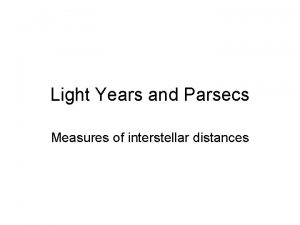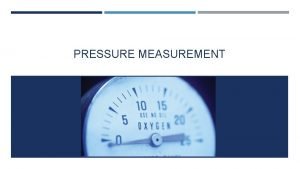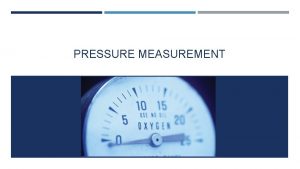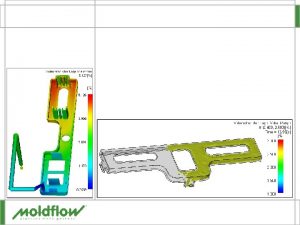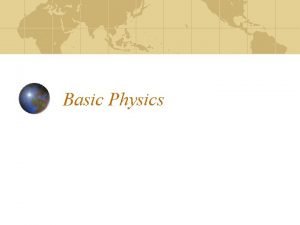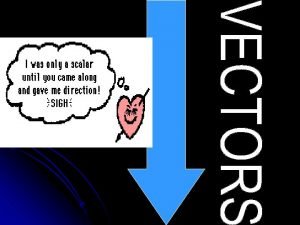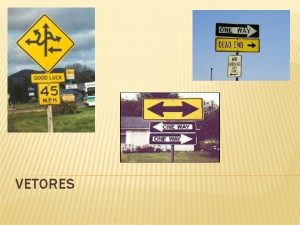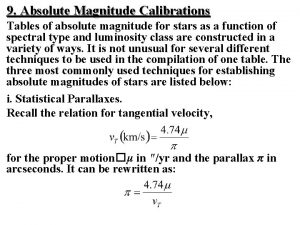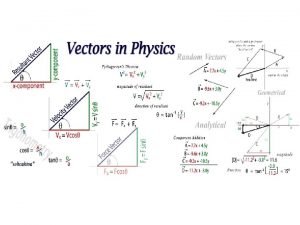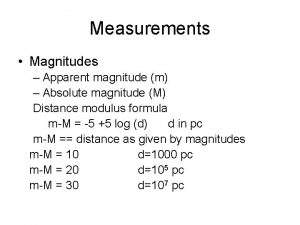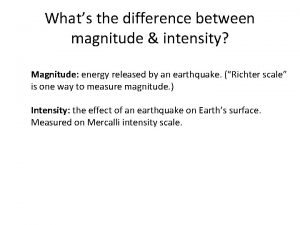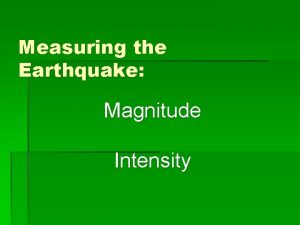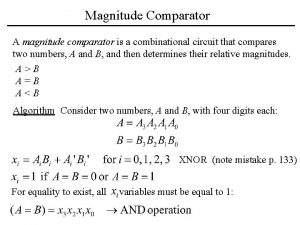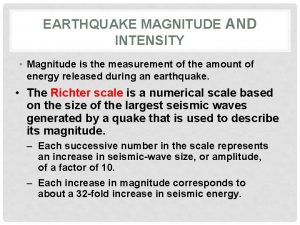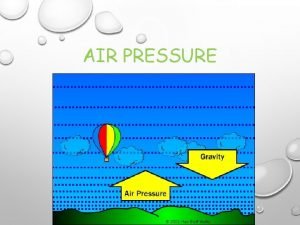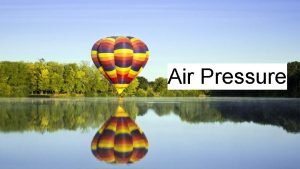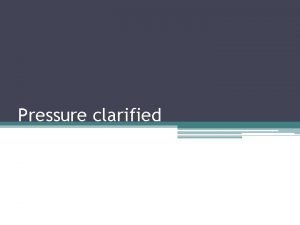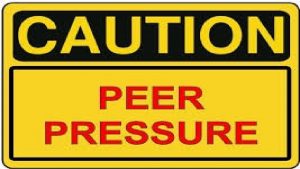Lesson 2 PRESSURE Pressure is the magnitude of





















- Slides: 21

Lesson 2 PRESSURE

Pressure is the magnitude of the force per unit area; the SI unit is the Pascal. This is represented with the equation

Rearranged formula Where p is the pressure in Newton’s per square meter (N/m 2), F is the magnitude of the force measured in Newtons (N), and A is the area measured in square meters (m 2), perpendicular to the force.

The Pascal was named after the French scientist Blaise Pascal, who contributed to the study of fluids. Because one Pascal is such a small unit, kilopascals are often used for tires and other uses.

Example 1 A flat-bottomed crate is 2. 0 m wide, 3. 0 m long, and 1. 0 m high. The magnitude of its weight (i. e the magnitude of the force of gravity on the cart) is 1. 2 x 104 n. A. Calculate the area of the crate in contact with the floor. B. Calculate the pressure the crate exerts on the floor in Pascal’s and Kilopascals. C. How would the pressure change if the box were standing on its end?

Example 1 (A) L = 3. 0 m W = 2. 0 m A=? A=lxw A = 3. 0 x 2. 0 m A = 6. 0 m 2 Therefore, the area of the crate in contact with the floor is 6. 0 m 2.

Example 1 (B) F = 1. 2 x 104 N A = 6. 0 m 2 p=? p = 2. 0 x 103 Pa or 2. 0 k. Pa Therefore, the crate exerts a pressure of 2. 0 k. Pa, on the floor.

Example 1 (C) h = 1. 0 m W = 2. 0 m A=? A=hxw A = 1. 0 x 2. 0 m A = 2. 0 m 2 Therefore, since the area is three times smaller, the pressure would be three times greater.

Atmospheric Pressure The air that we breathe stretches upward in layers. Each layer presses down on the one below. This results in a pressure known as atmospheric pressure, which is greatest at the Earth’s surface because of the weight of all the layers above

The pressure is reduced at higher altitudes; this causes ones ears to “pop” when the pressure inside the ear is greater than outside the ear and it escapes.

Atmospheric pressure is measured in Pascals and kilopascals. Standard atmospheric pressure, used by scientists is 101. 3 k. Pa, which is the average pressure at sea level.

Atmospheric pressures are closely monitored as they are particularly useful in weather forecasting. Constant pressure indicates little change, a decrease in pressure indicates a storm and an increase in pressure indicates fair weather

A drinking straw works by decreasing the air pressure inside the straw, the atmospheric pressure is than greater than that in the straw and forces the liquid to rise up in the straw.

Measuring Pressure Atmospheric pressure can be measured with several different tools; one of the tools that airplane pilots use is an altimeter.

An instrument that uses atmospheric pressure to determine the altitude of an airplane above sea level. Other tools include barometers, and aneroid barometers (a barometer without the use of a liquid).

A barometer consists of a sealed glass tube that is filled with mercury and placed upside down in a dish of mercury. This creates a vacuum at the top of the tube which does not contain any air. The atmospheric pressure is great enough to keep 76 cm of mercury in the tube.

As the atmospheric pressure increases the mercury will rise, and when the pressure decreases the mercury will fall. Water was originally used but the tube needed to be 10. 3 m high to hold all of the water that atmospheric pressure could hold up. This also explains why only shallow wells (no deeper than 10. 3 m) existed before submersible pumps existed.

An Aneroid barometer is a safer barometer to use as it does not contain mercury and is more convenient. It uses a sealed metal container with expandable sides that move with atmospheric pressure changes. When the sides move it moves a bar attached to a calibrated scale

Questions Give reasons for each of the following situations, emphasize the difference between force and pressure; An all-terrain vehicle has wide wheels C (1) It is much easier to break a walnut shell by hand using two walnuts pressed against each other than to break the shell with your hand alone. C (1) Calculate the pressure in each of the following; F = 4. 2 x 102 N, A = 0. 50 m 2 T (1) F = 6. 2 x 104 N, A = 2. 0 m 2 T (1) F = 3. 6 x 102 N, A = 3. 0 x 10 -2 m 2

Calculate the pressure, in Pascal’s and kilopascals, applied on the floor: by the toe of a ballet dancer’s shoe when she balances, briefly, on that toe. Assume that the dances mass is 56 kg and the surface area of the tip of her toe is 2. 0 x 10 -4 m 2 T (1) C (1) Repeat (a) for a circus elephant standing on two feet. Assume that the elephant’s mass is 5. 4 x 103 kg and the surface of each foot is 3. 0 x 10 -2 m 2. T (1) C (1) 8. 8 x 10 Pa 5 Calculate the unknown quantities: p = 2. 5 Pa, A = 0. 22 m 2, F = ? T (1) p = 4. 0 x 102 k. Pa, A = 0. 20 m 2, F =? T (1)

A Weather forecaster reports that in 6. 0 h the atmospheric pressure has changed from 100. 7 k. Pa to 100. 1 k. Pa. What prediction can be made about the weather? T (1) C (1) Explain why the best suction pump in the world can pull mercury in an open tube no higher than about 76 cm. Explain why T (1) C (1)
 What is a parsec?
What is a parsec? Hát kết hợp bộ gõ cơ thể
Hát kết hợp bộ gõ cơ thể Bổ thể
Bổ thể Tỉ lệ cơ thể trẻ em
Tỉ lệ cơ thể trẻ em Chó sói
Chó sói Tư thế worms-breton
Tư thế worms-breton Alleluia hat len nguoi oi
Alleluia hat len nguoi oi Các môn thể thao bắt đầu bằng tiếng nhảy
Các môn thể thao bắt đầu bằng tiếng nhảy Thế nào là hệ số cao nhất
Thế nào là hệ số cao nhất Các châu lục và đại dương trên thế giới
Các châu lục và đại dương trên thế giới Công thức tính độ biến thiên đông lượng
Công thức tính độ biến thiên đông lượng Trời xanh đây là của chúng ta thể thơ
Trời xanh đây là của chúng ta thể thơ Cách giải mật thư tọa độ
Cách giải mật thư tọa độ 101012 bằng
101012 bằng Phản ứng thế ankan
Phản ứng thế ankan Các châu lục và đại dương trên thế giới
Các châu lục và đại dương trên thế giới Thể thơ truyền thống
Thể thơ truyền thống Quá trình desamine hóa có thể tạo ra
Quá trình desamine hóa có thể tạo ra Một số thể thơ truyền thống
Một số thể thơ truyền thống Cái miệng xinh xinh thế chỉ nói điều hay thôi
Cái miệng xinh xinh thế chỉ nói điều hay thôi Vẽ hình chiếu vuông góc của vật thể sau
Vẽ hình chiếu vuông góc của vật thể sau
